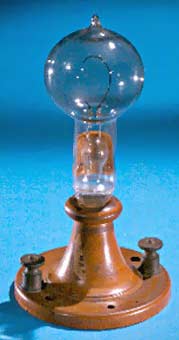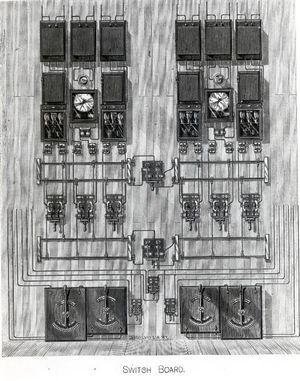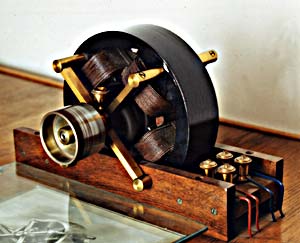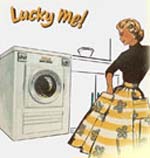Light and Power
Flick a switch and a light goes on. Flick it again and off it goes. Pretty simple. But developing a system that makes power so easily accessible took a lot of people a lot of hard work. It was also one of the most important things to take place in the late 19th century. Finding ways to generate and deliver power changed nearly everything about the way we live and work.
Most people think of Thomas Edison as the inventor of the light bulb, but that isn’t exactly true. Incandescent lighting—where an electrical current causes a filament to glow—had already been invented. The problem was that the light lasted only a few minutes because the filaments burned out. Edison found a way around that. In 1879 he came up with a workable filament that allowed light bulbs to burn much longer.
A light bulb with no electrical source wasn’t much good, however. Edison knew that a system of generating and distributing electrical power was needed and he set about creating one. In 1882, Edison opened the Pearl Street station in New York City. It was the world’s first commercial power plant. Although it was an enormous plant for its day, the station at Pearl Street was able to produce and distribute electricity to only one square mile of lower Manhattan.
Although it was successful, Edison’s system had problems and limitations. It used direct current (DC), which was not ideal for delivering electricity over long distances. Alternating current (AC) was better suited to the job. AC allows high voltage current to be transmitted through power lines and lowered before the customer gets it. But Edison was committed to DC.
Others, however, were determined to compete with Edison by using AC. AC worked fine with light bulbs, but it was not yet practical for powering electric motors. So the first step was to develop a good AC motor. Finding a way to produce a rotating magnetic field electrically, Nikola Tesla invented a practical AC motor in 1883. Several years later George Westinghouse bought the patents to the Tesla motor and set up an AC power system. For a while, Westinghouse and Edison were in a fierce competition to see whose system would dominate. The winner was clear after a new AC power plant opened at Niagara Falls in 1895 and was used to light up portions of Buffalo, New York. Its successful use in transmitting large amounts of power to distant places was the deciding factor. Today, the whole world continues to use AC.
The generation of large amounts of electricity and the development of reliable delivery systems changed the world. Once electricity was cheap and reliable, other inventions followed. Availability of electricity led to widespread use of electric appliances, some of which we still use today. In 1908 the vacuum cleaner came on the market. Five years later an appropriate motor (one that didn't need lubrication and was small in size) made the electric refrigerator possible. Washing machines and dishwashers soon came on the scene. In 1935 the clothes dryer was invented. Electricity eventually powered radios, televisions, refrigerators, computers, and countless other devices. Electricity was everywhere and it was changing the way people lived.
Today we use electricity for so many things that we take it for granted and often waste it by leaving lights burning in empty rooms or running appliances when it's not necessary. But engineers around the world are always working hard to find new ways to produce and distribute it. Many people outside of North America and Europe have little or no access to electricity. Even in the United States and Europe, where electricity is nearly universal, our use of it grows so fast that engineers have to always be on the lookout for new sources. Today’s engineers are looking for ways to make older forms of power plants more efficient and to exploit the untapped sources of energy all around us, like wind power, solar rays, and alternative fuels.
Further Reading
For more information on the history of the electrification of New York City, Joseph Cunningham’s book, York Power is available for purchase from Amazon.com



